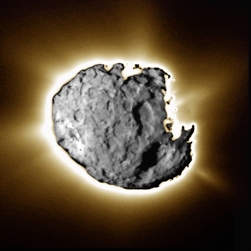
Spacebug
Joe McCall writes: Particles retrieved from the tail of comet Wild-2 by NASA Spacecraft Stardust have been exhaustively examined, and care taken to distinguish cometary material from terrestrial contaminants. Glycine has now been positively identified, an amino acid which is a fundamental building block of proteins1. Chains of amino acids are strung together to form protein molecules in everything from hair to enzymes that regulate chemical reactions within living organisms.
Amino acids have been found before in primitive carbonaceous chondrite meteorites, such as Orgueil, France and Murchison, Australia; but those from meteorites yield equal amounts of right-handed and left-handed molecules, whereas as Pasteur discovered, life processes always favour right-handedness2. This is the first discovery of an amino acid in cometary material. Glycine is recorded as being the only optically inactive amino acid3, so I am not sure whether any biogenicity test can be applied.
It is claimed that this discovery supports the idea that the building blocks of life are prevalent in space, strengthening the idea that life in the universe may be more common than we think.
Refs
- Gorman, S August 18 2009. Building block of life found on comet. Reuters. http://www.reuters.com/article/scienceNews/idUSTRE57H02I20090818
- Bevan, A & de Laeter, J 2002. Meteorites - a journey through space and time. Smithsonian Institution Press, Washington, D.C. & London, 215 pp.
- Jackson, J A 1997. Glossary of Geology. American Geological Institute, Alexandria, Virginia, 769 pp.